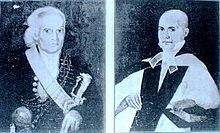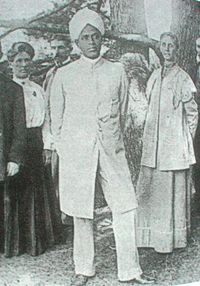- Sri Lankan Mudaliyars
-
Mudali (or Mudaliyar) was a colonial title & office in Sri Lanka. The Portuguese colonials created the Mudaliyar class in the 17th century by enlisting natives of different castes form the coastal areas, who were most likely to serve the Portuguese masters with utmost loyalty. The Dutch continued the practice of the Portuguese. This class used the Mudali as a hereditary title; however, the British re-established a Mudaliyar class, with appointments that had the title of Mudali, this process was stopped in the 1930s when the Native Department of the British government of Ceylon was closed down. All appointments of Mudaliyars were made by the Governor of Ceylon.
Contents
History
Mudaliyar is a South Indian and Tamil name for ‘first’ and a person endowed with wealth. It was created in the 17th century by the Portuguese function as a link between the colonial administration and the local populous, as they had done in South India. They received payment in form of land grants and use of tenured service (Rajakariya) of the local population which they extracted for their own estates.[1]
The 18th century Dutch rulers appointed a few Mudaliyars from the Tamil Vellalar caste. The British who succeeded the Dutch appointed large numbers of Mudaliyars from several castes and communities in the 19th century by enlisting natives who were most likely to serve the British masters with utmost loyalty. Most of them eventually claimed that they were from Salagama or Govigama castes Sinhalese caste[citation needed].
This class resembled English country squires, complete with large land grants from the British, residences of unprecedented scale - referred to by the Tamil word Walauu or Walvoo and the Sinhala word Walauwa - such as Richmond Castle in Kalutara - one of the largest mansions in Sri Lanka.[2] The British also granted privileges to the Mudaliyars of Ceylon.
In the north of Sri Lanka, in the city of Jaffna, there are least two or three clans from Thondaimandalam with the surname of 'Mudali.' Irumarapum Thooya Thaninayaga Mudali from Seyyoor and Mannadukonda Mudali whose clan has been quoted even during the time of the famous poet Kambar. The British gave the title of 'Mudaliyar 'to Ceylonese who served them until the closure of the Native Department of the British government of Ceylon in 1938.
The 4th Maha Mudliyar Christofel de Saram (assumed name Wanigasekera Ekanayake) and his son Johannes Hendrick. Johannes was one of two de Sarams sent to England for education at the expense of the British government. He sailed to England as a 14 year old boy, on 15 March 1811, with the retiring Governor Maitland.
The De Saram Family
A De Saram family of Dutch and Malay ancestry had Sinhalised itself in the late 18th century by posing as the representatives of the masses and subsequently convincing the British rulers that they were from the numerous Govigama caste. This was a strategic move as it gave the British masters the impression that the De Saram family had the backing of a large body of natives. It was also the easiest route to Sinhalisation as the peasant community was widely dispersed, still unstructured and without inter-community networks or leaders.
The first notable ancestor of the De Saram family was an interpreter who accompanied the Dutch Embassy to Kandy 1731–1732. Despite his advanced age of 71 years, this early De Saram had to make the entire journey by foot as his social status did not warrant travel in a palanquin (JRASCB XXI 197). From there, the De Saram family progressively gained power and position by loyalty, switching religions from Dutch Protestantism to British Anglicanism and benefitting from the preference of British rulers to appoint individuals of unknown ancestry to high positions. By respectively collaborating with the Dutch and British rulers, the De Sarams succeeded in marginalizing the traditional ruling class. The erroneous British notion of an inverted caste hierarchy in Sri Lanka is easily traceable to the documents on 'local customs' produced by this family. (See - The development and promotion of the Govi Supremacy Myth by these families).
The British naturally favored the subservient and cooperative De Saram family against the belligerent traditional elite. The De Saram family was given increasing patronage and chiefly appointments and it grew in power and influence during the British period.
Mudaliyar Don Spater Senanayake, son of Don Bartholomew who assumed the name Senanayake, with son-in-law F.H. Dias- Bandaranaike, sons Don Stephen Senanayake, Don Charles and Fredrick Richard, daughter Maria Frances and wife Dona Catherina Elizabeth Perera. They were Anglican Christians.
Governors Maitland (1805–1811), Gordon (1883–1890) and others effectively used divide and rule policies and created caste animosity among the native elite and finally confined all Native Headmen appointments only to the Govigama caste in 1897. A leading newspaper of the day ‘The Examiner’ stated in a letter on 30 March 1870 that the Muhandiram of Siyana Korale West was low in ability but was purely appointed for rendering domestic service to Mrs. Layard, the British Government Agent’s wife, for eight years, getting good meat for her from the public market.[3]
The De Saram family eventually had a strong and exclusive network of relatives as Mudaliyars by the late 19th century. Later, through marriage alliances the network extended to the Obeyesekere, Dias-Bandaranaike, Ilangakoon, de Alwis, de Livera, Pieris, Siriwardena and Senanayake families. This Anglican Christian, so called “Govigama”, network expanded further with the preponderance of native headmen appointments by the British as Mudaliyars, Korales and Vidanes from the Buddhist Govigama section of the community.
The creation of the above Mudaliyar class by the British in the 19th century, its restriction only to the Govigama caste in the 1890s, production of spurious caste hierarchy lists by this group (See creation of the Govi Supremacy Myth )and changes to the land tenure system, resulted in all other Sri Lankan castes being classified as low castes during this period.
The influential Mudaliyar class attempted to keep other Sri Lankan castes out of colonial appointments. The oppression by the Mudaliars and connected headmen extended to demanding subservience, service and even restrictions on the type of personal names that could be used by other castes.
The Ponnambalam-Coomaraswamy Family
As much as the De Sarams family was responsible for the rise of the Govigama caste, the Ponnambalam-Coomaraswamy Family was responsible for the 20th century, rise of the Tamil Vellala caste. The ascendance of the Ponnambalam-Coomaraswamy family commences with a Coomaraswamy (1783–1836) from Point Pedro joining the seminary that Governor North started for producing interpreters. Coomaraswamy passed out and served as an interpreter from 1805.
He was rewarded by the Governor with a Mudaliyar position at the age of 26 and became the Jaffna Tamil with the highest government appointment. He played a critical role as the Tamil-English interpreter when the Kandyan king Sri Wickrama Rajasinghe was captured in 1815. He was rewarded with a gold chain and medal by Governor Brownrigg in 1819 for loyal service to the British crown. (Vythilingam 36-43) There were allegations that he was not from the Vellala caste. (Jayawardena 209). James Rutnam's research has shown that Coomaraswamy's Father was Arumugampillai, a South Indian, who had migrated to Gurudavil in Jaffna. (Tribune 1957)
Arunachalam Ponnambalam’s (1814–87) step Father Ariyaputhira was Coomaraswamy’s brother-in-law and in 1844 Ponnambalam married Coomaraswamy’s daughter Selachchi.
 The influential businessman, James Edward Corea, a wealthy landowner from Chilaw was appointed Gate Mudaliyar by the Governor of Ceylon. He was placed in charge of the rural police of Pitigal Korale North. Gate Mudaliyar J.E.Corea came from an Anglican Christian background.
The influential businessman, James Edward Corea, a wealthy landowner from Chilaw was appointed Gate Mudaliyar by the Governor of Ceylon. He was placed in charge of the rural police of Pitigal Korale North. Gate Mudaliyar J.E.Corea came from an Anglican Christian background.
Ponnambalam was appointed cashier of the Colombo Kachcheri in 1845 and deputy Coroner for Colombo in 1847. Many leading Englishmen were his friends and it transpired in the 1849 Parliamentary Commission that he used to lend money to government officials. (Vythilingam 58)
His three sons P. Coomaraswamy (1849–1905), P. Ramanathan (1851–1930) and P. Arunachalam (1853–1926) were national figures and two of them, P. C. and P. A. married two daughters of Namasiyayam, an extremely successful Broker from Manipay. This closely related and endogamous clan emerged as the pre-eminent Tamil family of the country and rose to national elite status. (Jayawardena 210-212)
Despite their anglicized background which propelled their rise, the family presented a staunch Hindu appearance and assumed the role of ‘Patrons of the Vellalas in Colombo. However many of its members; Muttu Coomaraswamy, P. Coomaraswamy, P. Ramanathan married western women. Ananda Coomaraswamy was married four times to western women.
They helped many young Tamils to secure employment in English Banks and Mercantile establishments. On the death of Mudaliyar Coomaraswamy’s wife in 1897, the leading daily, ‘The Ceylon Independent’ wrote “to her and her husband, almost every important Hindu family in the city owes its rise”.
The 19th century Radalas
See The British Radalas for the class of ‘New Radalas’ created by 19th century British administrators in the Kandyan provinces of Sri Lanka.
The 20th century
The introduction of democracy in the early 20th century transferred political power to the above affiliated Senanayake, Wijewardene, Corea, Kotelawala, Jayewardene and Dias Bandaranaike families in the West and Southern parts of the country and to interconnected Vellala families in the north of Sri Lanka.
Despite their Anglican Christian background, these families were respectively accepted by the Sinhala Buddhist mass vote-base and the Tamil voters as their communal democratic leaders and representatives. Since the grant of independence by the British in 1948, Sri Lanka’s political power has rarely slipped away from this closely connected group and even so only for short periods.
However, it has always been the Catholic Church and not the Anglican denomination that has been at the receiving end of the religious antipathy of the Sinhala masses. Similarly the Sinhala Buddhists of Sri Lanka are the target of Tamil hostility for the atrocities perpetrated on them by this Anglican minority.
Ranks of British Mudaliyars
- Head Mudaliyar of the Governors Gate / Gate Mudaliyar
- Mudaliyar of the Governors Gate
- Gate Mudaliyar
- Mudaliyar of the Attepattu
- Mudaliyar
List of prominent Mudaliyars
- Sir Solomon Dias Bandaranike - Head Mudaliyar of the Governors Gate
- Abraham Mendis Gunasekera - Gate Mudaliyar
- L. M. W. Senanayake - Gate Mudaliyar
- Gate Mudaliyar James Edward Corea - Gate Mudaliyar of Chilaw
References
- ^ Ceylon Under British Rule, 1795-1932 By Lennox A. Mills
- ^ http://www.angelfire.com/planet/naturesl/richmond_castle/richmond_castle2.htm
- ^ D. S. Senanayake
Bibliography
- Jayawardena Kumari 2000 Nobodies to Somebodies - The Rise of the Colonial Bourgeoisie in Sri Lanka
- JRASCB The Journal of the Royal Asiatic Society Ceylon Branch XXI 1909 No. 62
- Peebles Patrick 1995 Social Change in Nineteenth Century Ceylon
- Vythilingam M. 1971 The life of Sir Ponnambalam Ramanathan Volume I
- A History of Sri Lanka By Professor K.M.De Silva (1981)
- Twentieth Century Impressions of Ceylon: Its History, People, Commerce, Industries and Resources By A.W. Wright, Asian Educational Services,India; New Ed edition (15 Dec 2007)
Categories:- Sri Lankan Tamil society
- Titles in Sri Lanka
- Sinhalese castes
- Sri Lankan Tamil caste
- Ceylonese recipients of British titles
- Defunct government posts
Wikimedia Foundation. 2010.



